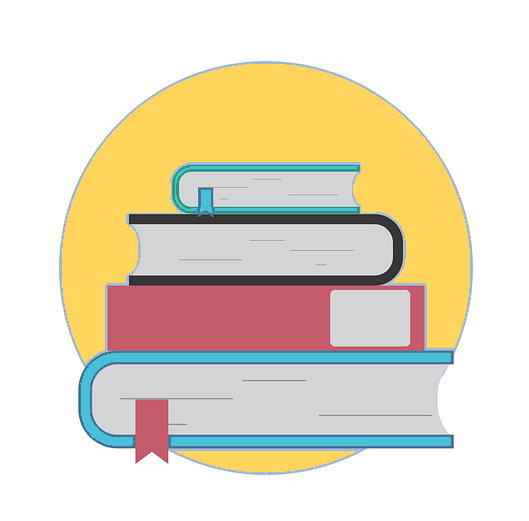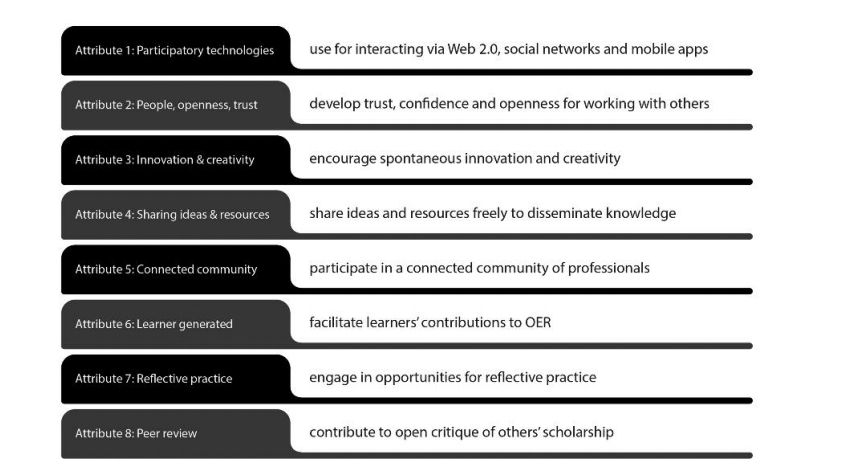98
So far, we’ve been exploring how the use of OER can help to ensure that learning materials are free of cost and access barriers. OER can also support academic freedom by enabling instructors to modify or add additional content to the materials to fit their specifications and goals, which in turn creates the opportunity to provide more relevant and engaging materials for students. Now, we’ll look at how principles of open scholarship can be incorporated into the practice of teaching and learning.
Social and Equitable Practices
Open scholarship, as we’ve been learning, is founded on the premise of barrier-free and equitable access to knowledge, with the understanding that the creation and dissemination of knowledge is a social practice. Under this umbrella term, open education encompasses a set of practices directed at making the process and products of education more transparent, understandable, and available to all people. While open education includes the creation and use of OER to achieve these goals, it also includes the application of openness to the practices of teaching and learning (i.e. the pedagogy) and strives to support equitable participation in the creation of knowledge.
The core values for open pedagogy, as Caroline Sinkinson states, include teaching and learning practices that reduce barriers that prevent equitable access to education, including economic, technical, social, cultural, and political factors. Open pedagogy facilitates connections across the boundaries of learning experiences that occur within classrooms, on campuses, and in communities by critically engaging with tools and practices that mediate learning, knowledge building, and sharing. Open pedagogy also protects the agency and ownership of one’s own learning experiences, choices of expression, and degrees of participation and resists the treatment of open as neutral by providing space for critical evaluation and reflection.
Open pedagogy is thus situated at the intersection of teaching and learning and social justice and often builds upon theories of critical pedagogy which sought to use the educational process to challenge existing knowledge and beliefs in order to achieve individual empowerment and social change. Earlier critical pedagogists, such as Paulo Freire, saw education as a librating and transformative practice or a practice in conformity:
“Education either functions as an instrument which is used to facilitate the integration of the younger generation into the logic of the present system and bring about conformity or it becomes the practice of freedom, the means by which men and women deal critically and creatively with reality and discover how to participate in the transformation of their world.” -Paulo Freire, Pedagogy of the Oppressed
Critical pedagogy is an educational philosophy drawn from critical theory where instructors and students critically evaluate systems of power in order to understand the oppressive nature of social and political systems. Critical pedagogists, such as Freire, argued that applying critical theory to education, “allows students to recognize connections between their individual problems and the broader social contexts in which their experiences are embedded”. Open pedagogy applies much of the earlier work of critical pedagogy to the modern teaching contexts and encompasses a social justice approach to the collaborative and transparent construction of knowledge made openly available through networked technologies.

Dig Deeper
To learn more about critical pedagogy, read:
- Freire, P. (1968). Pedagogy of the Oppressed. New York: Seabury Pres
- Kirylo, D., Thirumurthy, V., Smith, M. and McLaren, P. (2010). Issues in Education: Critical Pedagogy: An Overview, Childhood Education.
Defining Open Pedagogy
Having a single definition of open pedagogy can be challenging. David Wiley initially suggested that open licensing of educational materials and permissions for re-use are essential: “Open pedagogy is that set of teaching and learning practices only possible in the context of the free access and 5R permissions characteristic of open educational resources.” Many different scholars and educators have put forth additional definitions of open pedagogy that address aspects of the teaching and learning process that go beyond the use of open resources. These definitions include:
- A blend of strategies, technologies, and networked communities that make the process and products of education more transparent, understandable, and available to all the people involved. — Tom Woodward
- The potential of openness and sharing to improve learning, as well as a social justice orientation – caring about equity, with openness as one way to achieve this. — Maja Bali
- The ability for learners to shape and take ownership of their own education — Devon Ritter
- A means to connect with a broader, global community as well as a means to challenge and expand existing understandings of student centre learning — Tannis Morgan
- Freedom of action and authority — Jim Luke
- The shift of emphasis to student contribution to knowledge as opposed to simple consumption of knowledge — Heather Ross
Features and Attributes of Open Pedagogy
What are the commonalities across the different approaches to open pedagogy?
Tom Woodward highlights three features of open pedagogy:
- open planning: Prior to the start of a course built on open pedagogy there is a focus on collaboration regarding what the course might be — the content, the lessons, the tools of construction, and the teaching strategies…You can see what other instructors have done — their resources, their lessons, or their reflections on what happened during their course. As Tom points out, these processes are often hidden from public view. Making them open and accessible means that others can learn from them.
- open products: Students are publishing for an audience greater than their instructor. That matters. Their work, being open, has the potential to be used for something larger than the course itself and to be part of a larger global conversation. This changes the experience of doing the work, but just as importantly it changes the kind of work you ask students to do.
- open reflection: After the course, reflecting and documenting how the course went is valuable both to the instructor and to those who might be considering similar courses or pedagogical strategies. People are happy enough to present and document success but it’s still not common practice to reflect on elements that don’t work well. Documenting reflections on what worked and what didn’t and making that public can lead to connections between people working to address the same challenges.
One could also consider a fourth feature:
- open process (of creating OER): If you or your students create open educational resources for a course, it’s useful to share not just the finished resources but also the processes of creating them. Sharing the process can mean many things, e.g., talking about how you made a teaching resource such as a video or podcast (what tools, software, what steps you took, pitfalls you ran into), describing why you created the resource in the way you did (what goals you had, what research underlies the creation of this resource), explaining how you have used the resource in a class and whether it was successful.
Bronwyn Hegarty suggests that are eight attributes of open pedagogy inform its features. These attributes include the use of participatory or social technologies, such as blogs or wikis, which facilitate learners being exposed to ideas and experts beyond their institutional walls, but also to diverse modes of sharing and collaboration. Additionally, as students’ willingness to learn and stretch their boundaries in open spaces can be fragile, another attribute in open pedagogy is openness, trust, and people. Providing support and using scaffolding to build confidence and independence in an open learning situation can help motivate students.

Another attribute Hegarty suggests is innovation and creativity. The exploration and choice of emerging technologies and new methods that take advantage of the rights inherent in OER as well as facilitate another attribute of open pedagogy, the sharing of ideas and resources. Open pedagogy relies upon peers to share willingly within connected communities. The use of technologies to connect communities can enable collaboration, sharing, and participation, which can enhance the quality and diversity of learning resources and ideas but also teaching methods and the design of learning environments.
Another attribute is that open pedagogy is learner-generated, which involves ‘opening up’ the process of teaching and learning to empower students to take the lead, solve problems, and work collectively to produce artifacts that they share, discuss, re-configure, and re-deploy. Building relationships where groups of learners work collectively, with reflective learning and peer review as natural outcomes, Hegarty states, is paramount to open pedagogy. Co-constructing knowledge through facilitated and shared reflective practice can drive deeper pedagogical reflection and student engagement. A vital component of reflective practice is the use of open tools for peer feedback and interactions, which can lead to transformational change.
Open Educational Practices
“Open educational practice” is a term that could actually cover any open teaching and learning activities, but we are using it here to designate teaching and learning activities that are further towards the “fully open” side of the spectrum. In this sense, open practice involves going beyond adopting a few open resources in one’s courses or posting faculty or student work publicly.
Open practice may involve:
- Using all and only open resources in one’s course, such as readings that are not only free to read, but also openly licensed to allow downloading, revision, annotating, etc.
- One’s entire course site is public and openly licensed even if one doesn’t post ALL aspects of a course publicly. Of course, things such as student marks should remain private, and one may also choose to not post exams so they can be reused later.
- Any student work or instructor teaching and learning resources that are posted to a public site are also given an open license.
- Openness extends to getting and incorporating feedback on the course and its open resources, whether instructor-produced or student-produced.
- Not only products are open (such as the course site, teaching and learning resources, student work), but also processes. For example, one shares the processes of designing a course, of how a video was created, of how well a particular open assignment worked, etc.
- One could open an entire course to participants from outside the institution (such as in a MOOC), still ensuring that the course elements are openly licensed

Reflections
Please read the following statement:
Open pedagogy is the natural progression of integrating socially just principles of human relations and the potential of current technology into the educational system. If we believe education leads to human flourishing and that education is a right, then the use and creation of OER in tandem with effective teaching and learning strategies (that is, open pedagogy) is required to establish and protect that right. Open pedagogy fulfills one of the core commitments to a democratic system by cultivating an informed, educated, and engaged electorate…In fact, my theoretical approach to teaching draws directly from critical pedagogy which emphasizes the awakening of a critical consciousness. Critical pedagogy questions the institutions and practices of education by supporting an approach that emphasizes teaching as a political act, learner-centered practices, praxis, the co-production of knowledge, and the educator as a facilitator. I believe practicing contemporary critical pedagogy requires engaging with OER and therefore leads naturally to experiments in open pedagogy
– Dr. Arthur Gill Green, Affiliate Assistant Professor, UBC Geography.
What influences your teaching or learning practices? Do you agree or disagree that teaching is a political act? Why or why not?

Dig Deeper
To learn more about about how different scholars are defining of open pedagogy, please read:
- DeRosa, R. & Jhangiani, R. (2017). Open pedagogy. Open Pedagogy Notebook.
- Schuwer, R. (2017). April open perspective: what is open pedagogy?. Year of Open.
- Sinkinson, C. (2018). The values of open pedagogy. Educause.
